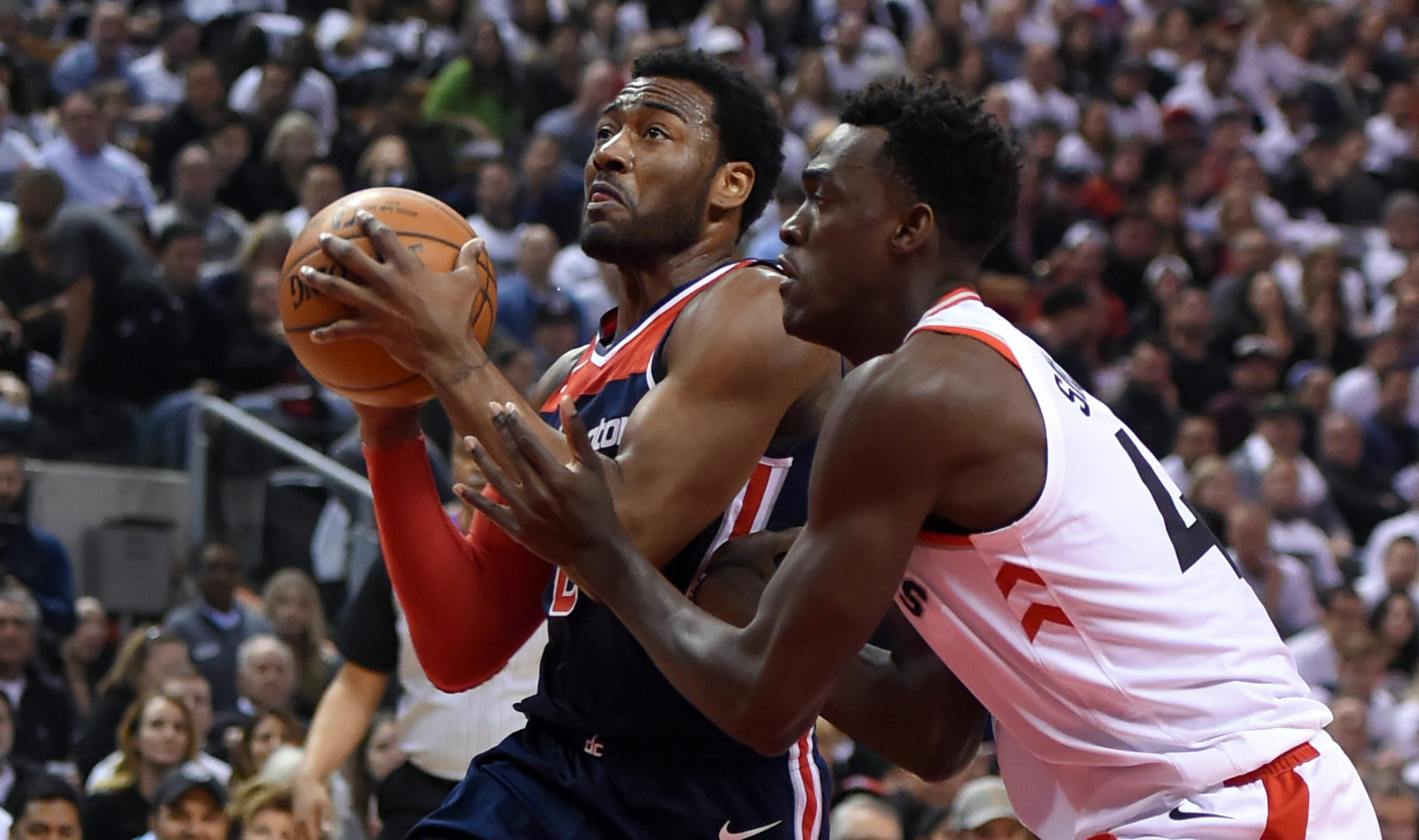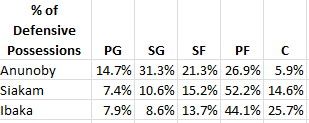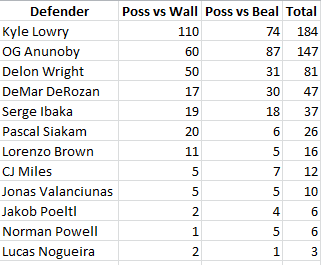One of the first tests of Pascal Siakam’s career was Bradley Beal. Forced into starting duty out of the gate as a rookie last season, Siakam underwent what head coach Dwane Casey became fond of calling a “baptism by fire.” A nominal power forward, the Toronto Raptors used their twitchy freshman on just about everyone who came around in his first few weeks. He was guarding Kevin Durant one night, Kevin Love the next, guarding centers out of position at the four, and switching capably on to perimeter players like Beal. And while Siakam’s first turn as a starter ultimately ended with him heading to the G League to refine his game, the lasting impression was that, with a little bit of work, Siakam could be a really useful, versatile defender.
It hasn’t taken him long to get there. Once Siakam had even a crack of opportunity this season, he never looked back – after starting the season out of the rotation, he appeared in the team’s final 79 games, averaging 20.7 minutes. His offensive improvements were dramatic everywhere beyond the arc, as Siakam added to a role card that mostly saw him subsisting on transition run-outs in Year One. He could now drive, create for himself, and, eventually, create for others. A great way to get around a nascent shooting touch is to be able to create with the ball in your hands, and Siakam growth there made him an instrumental part of a highly successful bench unit.
Through that growth, it was still Siakam’s defense that was most important and most impressive. He’d finish the season with the second-best defensive rating of the 11 players in the primary rotation and the third-best net rating. He was second on the team in fourth-quarter minutes, owing in part to the team’s rotation patterns and also do the trust he’d built staying on the floor late (he was sixth on the team in clutch minutes, too, though those didn’t go particularly well for the Raptors). Siakam was frequently being tasked with tough assignments once again, sharing the burden of LeBron James or Giannis Antetokounmpo or his best-case comparison de jour, Draymond Green.
It’s his versatility on that end of the floor that makes him so valuable. The Raptors were aggressive in having Siakam, OG Anunoby, and Serge Ibaka guard multiple positions, and Siakam wound up spending a fair amount of time checking all five spots on the floor, per estimates from Krishna Narsu of Nylon Calculus using NBA.com’s new matchup data. Based on my own estimates, there were only 54 players in the NBA this year to play at least 2,500 defensive possessions and spend at least five percent of their time at all five positions, and the Raptors employed three of them. It’s that type of versatility that unlocks options against the league’s elite, giving Casey the chance to throw different looks at “power threes” or ball-dominant twos, or to switch freely across multiple perimeter positions, something the Raptors did a lot of this year.
It’s also the type of versatility that lead Casey to try Siakam out as a John Wall cooler in Game 4.
Wall leads the series in minutes so far, and the combination of him playing such heavy minutes and Bradley Beal running around beside him makes the Wizards an incredibly difficult team to guard on the perimeter. The Raptors have mostly tasked Kyle Lowry and Anunoby with the responsibility of Wall and Beal, with Delon Wright playing a sizable role and everyone else sharing chances as required. And that makes sense. Lowry and Anunoby start and are two of the team’s best defenders, and Wright is the best backcourt defender they have available to them off the bench. Siakam, though, hasn’t seen a lot of time on either despite playing 31 minutes opposite Wall (+8 for the Wizards) and 27 against Beal (+1 for the Wizards).
(As a note, NBA.com assigns a defender responsibility for the matchup based only on the amount of time spent on a player that possession, so Lowry could defend Wall for 15 seconds, Wall gets a late switch, and Lowry is still his primary defender. The data is likely very noisy in small samples and should only really be used descriptively or to ask questions over just four games. Hopefully when multiple seasons of data are available, there’s some predictive value in the larger, season-long samples we have that we’ll get into in a bit.)
That changed in Game 4, as Casey gave Siakam the assignment for a stretch of the second half. Wall was cooking to this point in the game, and Siakam was tasked with some possessions opposite him in the star-and-bench lineups. Casey noted after the game that it’s something the Raptors had worked on, and the logic seemed sound – Siakam can pick Wall up in the backcourt and stay with him to slow down his transition attacks, it allowed Wright to stay on Ty Lawson, and the Wizards being small meant there was no size mismatch elsewhere from putting Siakam on a guard.
It didn’t go seamlessly to start, with Wright getting caught on a screen, Siakam closing out aggressively at Lawson, and the scramble resulting in a floater for Mike Scott. You already see the idea, though, with Siakam’s quickness and recovery speed on display.
The next time down, Siakam’s ability to corral Wall in transition is on display, as he gets wide while back-peadlling and angles Wall off to where he only has a tough dish to the opposite corner available to him.
Then, Siakam encourages Wall to slow down rather than attacking in semi-transition. He and C.J. Miles miscommunicate on the sideline, though, bumping into each other and leading to a Jakob Poeltl foul.
There’s not much to this end-of-quarter possession – Siakam is giving Wall a ton of space and it’s notable that Washington keeps attacking Miles, but really this is just Scott doing what he’s done all series (he’s shooting 69 percent overall, which is not nice, 60 percent on threes, leads the NBA in postseason effective field-goal percentage, and has the series’ best net rating).
The fourth starts out with a gem of a possession from Siakam. First, he makes Wall work for position just to receive the inbound, picking him up full court. When the ball gets back to Wall, Wall sizes Siakam up with plenty of space, probes the situation a bit, and is dissuaded by Siakam’s twitchy feet, long arms, and positioning. He eventually resets, calls for a screen, then forces a bad pull up over Poeltl.
Wall essentially bows out of the next play, letting Lawson initiate after sizing things up. On the next, Wall is able to use his speed along the baseline to force a switch onto Miles, though Miles does a good enough job to force a turnover.
Washington calls a timeout here, as a mini-run from Toronto has them up six. That brings Beal back, making all of this more complicated for Toronto’s defense. Siakam is again picking Wall up full court, though they’re not involved much in the play. Instead, Wright does what Wright does, coming up with a steal and a bucket. It starts going downhill from here, as Beal misses a three but then scores after an offensive rebound.
Before things go off the rails, Siakam and Poeltl have another great possession defending a Wall pick-and-roll.
Siakam then gets beat by a nifty hesitation from Beal on the catch in transition, misses a push shot on the block, then loses Beal as a trailer in transition for a three, initially thinking he has Wall, who Wright has covered. One uncontested Wall mid-range jumper later – Siakam couldn’t get around an…interesting Gortat screen – and Siakam’s night was done.
All told, he showed some nice flashes slowing Wall down and keeping him away from the rim. Wall’s now scored five points on 20 possessions assigned to Siakam as a defender on him in the series, and the Wizards have scored five fewer points per-100 possessions than expected during that stretch.
“We like what we saw,” Casey said Monday. “I’m not gonna go into schemes or matchups or things like that as far as putting it out there, no, not even a little bit. We’ll talk about games in general but not gonna advertise. We don’t have anything to prove as far as talking about decisions and adjustments or anything like that.”
This shouldn’t be entirely surprising, as Siakam’s done a solid job against guards all year. Based on data provided to Raptors Republic from Narsu, Siakam has held opposing guards to a 51.2 true-shooting percentage over his 600 estimated possessions guarding them this year (the worst team in the league had a 52.9 true-shooting percentage, for reference). Were it not for fouling, this would look even better – their effective field-goal percentage is just 43.7 (the worst team was 49.5). Opponents scored well at the team level in that time (108 points per-100 possessions), but Siakam did well individually, based on the estimates we can make with our limited data.
(An aside: Anunoby was nearly as good, holding guards to a 52.3-percent true-shooting mark over almost 1,400 possessions, and opponents as a team scored just 104.4 points per-100 possessions in that time.)
Siakam hasn’t been particularly effective all series, but him ranking ninth on the team in minutes is a little surprising, even with the negative outcome in terms of net rating. If the Raptors are going to insist on going smaller (they should not, by the way), an Anunoby-Siakam-Ibaka frontcourt offers a lot of defensive value and versatility at the cost of unfamiliarity (that trio had a 34.3 net rating in 18 minutes this year and got outscored 4-0 in its two minutes together in this series). A Siakam-Ibaka pairing (+12.6 net rating in 176 minutes) seems preferable opposite Washington’s small closing looks, too, compared to an Ibaka-Poeltl combination that’s struggled most of the year. Siakam introduces some offensive spacing issues since Washington is going to dare him to shoot exceptionally open threes (the Raptors have a woeful 97.3 offensive rating in his minutes, second-worst of the regulars in the series), but if Toronto wants to vary it’s looks on Wall and Beal and inject some flexibility into their defensive approach, Siakam is one of the better bets they have to try out.






